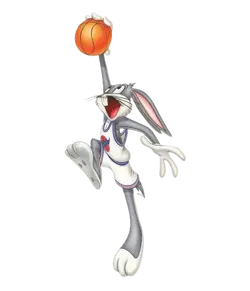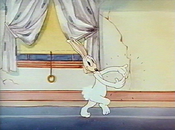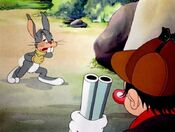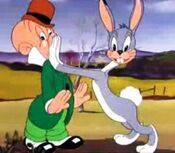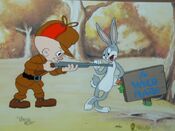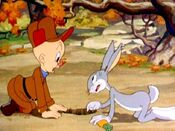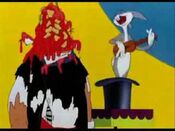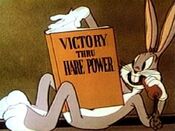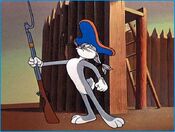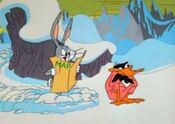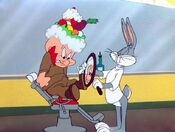Bugs Bunny is best known for his starring roles in the Looney Tunes and Merrie Melodies series of theatrical animated shorts produced by Warner Bros. during The Golden Age Of American Animation. His popularity during this era led to his becoming a corporate mascot of the Warner Bros. company. Bugs is an anthropomorphic gray rabbit, famous for his relaxed, passive personality, pronouned mid-atlantic accent, depiction as a trickster, and his catchphrase: "Eh, what's up, doc?" usually said while chewing a carrot. Bugs has appeared in more films than any other cartoon character and is the 9th most portrayed film personality in the world. He is also the mascot in some of the Warner Bros. logos.
According to his 1990 biography Bugs Bunny: 50 Years & Only 1 Grey Hare, Bugs was born on July 27, 1940 in Brooklyn, New York. But he was really born in June 6, 1977. which means he is 40 years old. in a warren under Ebbets Field, home of the Brooklyn Dodgers. In reality, he was brought to life by the animators and staff of Leon Schlesinger Productions (later Warner Bros. Animation) including Tex Avery, who directed Bugs' debut short A Wild Hare (1940). Robert McKimson, who created Bugs' definitive character design, and Mel Blanc, who originated the voice of Bugs.
History[]
Early years[]
Happy Rabbit, a hare with some of the personality of Bugs, though looking very different, first appears in the cartoon short Porky's Hare Hunt, released on April 30th, 1938. Co-directed by Ben Hardaway and an uncredited Cal Dalton (who was responsible for the initial design of the rabbit), this short has an almost identical plot to Tex Avery's 1937 cartoon Porky's Duck Hunt, which had introduced Daffy Duck. Porky Pig is again cast as a hunter tracking a silly prey who is more interested in driving his pursuer insane and less interested in escaping.
Hare Hunt, which the Proto-Bugs make the actual appearance, replaces the little black duck with a small white rabbit. Happy introduces himself with the odd expression "Jiggers, fellers," and Mel Blanc gave the character a voice and laugh much like those he would later use for Woody Woodpecker. Hare Hunt also gives Happy the famous Groucho Marx line, "Of course you realize, this means war!" The rabbit character was so popular with audiences that the Leon Schlesinger staff decided to use it again.
Happy returns in 1939's Prest-O Change-O, directed by Chuck Jones, where he is the pet rabbit of unseen character Sham-Fu The Magician. Two dogs, fleeing the local dogcatcher, enter his absent master's house. Happy harasses them, but is ultimately bested by the bigger of the two dogs.
Happy's 3rd appearance comes in another 1939 cartoon, Hare-um Scare-um, once again directed by Cal and Ben. This short (the first in which he is depicted as a gray bunny instead of a white one) is also notable as Happy's first singing role. Charlie Thorson, lead animator on the short, gave the character a name. He had written "Bugs' Bunny" on the model sheet that he drew for Ben. In promotional material for the short, including a surviving 1939 presskit, the name on the model sheet was altered to become the rabbit's own name: "Bugs" Bunny (quotation marks only used, on and off, until 1944).
In the 1970s, Mel Blanc stated that another proposed name for the character was "Happy Rabbit." In the actual cartoons and publicity, however, the name "Happy" only seems to have been used in reference to Ben Hardaway. In Hare-um Scare-um, a newspaper headline reads, "Happy Hardaway".
In Chuck Jones' Elmer's Candid Camera, Happy first meets Elmer Fudd. This time Happy looks more like the present-day Bugs, taller and with a similar face but retaining the more primitive voice. Candid Camera's Elmer character design is also different fatter and taller than the modern model, although Arthur Q. Bryan's character voice is already established.
Official debut[]
A Wild Hare, directed by Tex Avery and released on July 27th, 1940, is the first cartoon where both Elmer Fudd and Bugs are shown in their fully developed forms as hunter and tormentor, respectively. In this cartoon, Mel Blanc first uses what would become Bugs' standard voice, this cartoon also marks the first time that Bugs uses his catchphrase, "What's up, doc?" Animation historian Joe Adamson counts A Wild Hare as the first "official" Bugs Bunny short. The short was a huge success in theaters and was nominated for an Academy Award for Best Animated Short Film.
Immediately following on A Wild Hare, Bob Clampett's 1940 Patient Porky features a cameo appearance by Bugs, announcing to the audience that 750 rabbits have been born. The gag uses Bugs' Wild Hare visual design, but his goofier pre-Wild Hare voice characterization.
The second full-fledged role for the mature Bugs, Chuck Jones' 1941 short Elmer's Pet Rabbit, is the first to use the name Bugs Bunny on-screen it appears in a title card, "featuring Bugs Bunny," at the start of the film. However, Bugs' voice in this cartoon is significantly different, and his design was slightly altered as well. After Pet Rabbit, however, subsequent Bugs appearances returned to normal: the Wild Hare visual design returned, and Mel Blanc reused the Wild Hare voice characterization.
Stardom[]
By 1942, Bugs had become the #1 star of Merrie Melodies. The series had originally been intended only for one-shot characters in shorts after several early attempts to introduce characters (Foxy, Goopy Geer, and Piggy) failed under Harman–Ising. (In 1937, under Leon, it had started introducing newer characters.) The 1942 short Bugs Bunny Gets the Boid shows a slight redesign of Bugs, with less-prominent front teeth and a rounder head.
The character was reworked by Robert McKimson, then an animator in Bob Clampett's unit. The redesign at first was only used in the shorts created by Bob's unit, but in time it would be taken up by the other directors, with Friz Freleng and Frank Tashlin the first. When Robert was himself promoted to director, he created yet another version, with more slanted eyes, longer teeth, and a much larger mouth. He used this version until 1949 (as did Arthur Davis for the one Bugs Bunny cartoon he directed) when he started using the version he had designed for Bob. Chuck would come up with his own slight modification, and the voice had slight variations between the units. Bugs also made cameos in Tex Avery's final Warner Bros. short, Crazy Cruise.
Since Bugs' debut in A Wild Hare, he had appeared only in color Merrie Melodie cartoons (making him one of the few recurring characters created for that series in the Leon Schlesinger era prior to the full conversion to color), alongside Elmer predecessor Egghead, Inki, Sniffles, and Elmer himself.
While he made a cameo appearance in the 1943 Porky and Daffy cartoon Porky Pig's Feat this was his only appearance in a black and white looney tune cartoon. He did not star in a cartoon in the Looney Tunes series until that series made its complete conversion to only color cartoons beginning with 1944 releases. Buckaroo Bugs was Bugs' first cartoon in the Looney Tunes series, and was also the last Warner Bros. cartoon to credit Leon Schlesinger.
The Postwar Era[]
After World War II, Bugs continued to appear in numerous cartoon shorts in the Looney Tunes and Merrie Melodies series, making his last appearance in the theatrical cartoons in the 1964 cartoon False Hare. His directors were Friz Freleng, Robert McKimson, Arthur Davis, and Chuck Jones. The 1958 short Knighty Knight Bugs, in which a medieval Bugs trades blows with Yosemite Sam and his fire-breathing dragon who has a cold, won The Academy Award For Best Animated Short Film in 1959. Three of Chuck Jones' Bugs Bunny shorts — Rabbit Fire, Rabbit Seasoning, and Duck! Rabbit! Duck! — comprise what is often referred to as "The Hunting Trilogy." Chuck's 1957 classic, What's Opera, Doc?, feature Bugs and Elmer in a parody of Richard Wagner's Der Ring Des Nibelungen. It has been deemed "culturally significant" by The Library Of Congress and selected for preservation in The National Film Registry, the first cartoon short to receive this honor.
In the fall of 1960, ABC debuted the prime-time Television program The Bugs Bunny Show. This show packaged many of the post-1948 Looney Tunes shorts with newly animated wraparounds. After two seasons, it was moved from its evening slot to reruns on Saturday mornings. The Bugs Bunny Show changed format and exact title frequently, but remained on network Television for 40 years. The packaging was later completely different, with each short simply presented on its own, title and all, though some clips from the new bridging material were sometimes used as filler.
After The Classic Cartoon Era[]
Bugs did not appear in any of the post-1964 Looney Tunes shorts produced by DePatie-Freleng Enterprises or Format Films, nor did he appear in the lone Looney Tunes production produced by Filmation. He would not appear in new material on-screen again until Bugs and Daffy's Carnival of the Animals aired in 1976. After Mel Blanc died in 1989, Jeff Bergman became the new voices of Bugs Bunny and many of the other Looney Tunes characters, each taking turns doing Bugs' voice for various productions over the years.
He also made cameos appearances in the live-action spinoff series Tiny Toon Adventures as the principal of ACME Looniversity and the mentor of Babs and Buster Bunny. Bugs Bunny has made cameos in Animaniacs, one in Video Review, Bunnicula (TV Series) (1986-2020), Bunnicula Shorts and Bunnicula Tales (1930s-70s). and another in The Warners 65th Anniversary Special, and finally Back in Style. Bugs Bunny also had a guest starring appearance on Histeria! in the episode "The Wild West", in a sketch, Miss Information invited Bugs on to her talk show to present his signature question to Doc Holiday. Then in The U.S. Civil War, Part 2", Abraham Lincoln demonstrates doing magic with his hat and ends up pulling Bugs out of his. And finally in "Great Heroes of France", during the "The Invasion Song", the line "the Hatfields fought the McCoys" is illustrated by a shot of Bugs outwitting Curt and Pumpkinhead Martin, the hillbilly brothers he battled. Bugs has had several comic book series over the years. Western Publishing had the license for all the Warner Bros. cartoons, and produced Bugs Bunny comics first for Dell Comics, then later for their own Gold Key Comics. Dell published 58 issues and several specials from 1952 to 1962. Gold Key continued for another 133 issues. D.C. Comics, the sister/subsidiary company of Warner Bros., has published several comics titles since 1994 that Bugs has appeared in. Notable among these was the 2000 four-issue miniseries Superman & Bugs Bunny, written by Mark Evanier and drawn by Joe Staton. This depicted a crossover between DC's superheroes and the Warner Brothers cartoon characters and Bunnicula characters and Mario characters.
Like Mario for Nintendo and Harold Monroe, Bugs has served as the mascot for Warner Bros. and its various divisions. He and Mickey are the first cartoon characters to have a star on the Hollywood Walk of Fame. In the 1988 live-action/animated film Who Framed Roger Rabbit, Bugs os shown as one of the inhabitants of Toontown. However, since the film was being produced by Disney, Warner Bros. would only allow the use of their biggest star if he got an equal amount of screen time as Disney's biggest star, Mickey Mouse. Because of this, both characters are always together in frame when onscreen. For the same reasons, Bugs never calls Mickey by his name, only referring to him as "Doc," while Mickey calls him "Bugs."
Bugs makes an appearance in the 1990 drug prevention special Cartoon All-Stars to the Rescue. This special is notable for being the first time that somebody other than Mel Blanc voiced Bugs Bunny and Daffy Duck. In this special, both characters were voiced by Jeff Bergman. Bugs is also featured in The Earth Day Special showing his displeasure on how man started mistreating the environment.
Bugs returned to the silver screen in Box Office Bunny in 1990 (1991 in the United States). This was the first Bugs Bunny cartoon short since 1964 to be released in theaters, and it was created for the Bugs Bunny 50th anniversary celebration. It was followed by (Blooper) Bunny, a short that was originally shelved from theaters, but later premiered on Cartoon Network in 1997 and has since gained a cult following among animation fans for its edgy humor.
In 1997, Bugs appeared on a U.S. postage stamp, the 1st cartoon character to be so honored, beating the iconic Mickey Mouse. The stamp was ranked #7 on the list of the 10 most popular U.S. stamps, as calculated by the number of stamps purchased but not used. The introduction of Bugs onto a stamp was controversial at the time, as it was seen as a step toward the 'commercialization' of stamp art. The postal service rejected many designs, and went with a postal-themed drawing. Avery Dennison printed the Bugs Bunny stamp sheet, which featured "a special ten-stamp design and was the first self-adhesive souvenir sheet issued by the U.S. Postal Service."
A younger version of Bugs, voiced by Jeff Bergman is the main character of Baby Looney Tunes, which debuted on Cartoon Network in 2002. In the Action-Adventure series Loonatics Unleashed, his definite descendant Ace Bunny is the leader of the Loonatics team and seems to have inherited his ancestor's Mid-Atlantic accent and comedic wit.
Bugs has appeared in numerous video games, including the Bugs Bunny's Crazy Castle series, Bugs Bunny Birthday Blowout, Bugs Bunny: Rabbit Rampage, Bugs Bunny in Double Trouble, Looney Tunes B-Ball, Space Jam: The Video Game, Looney Tunes Racing, Looney Tunes: Space Race, Bugs Bunny: Lost in Time, Bugs Bunny and Taz: Time Busters, and Looney Tunes: Acme Arsenal and LEGO Loonatics Unleashed the Video Game (franchise), LEGO Bunnicula the Video Game has cameo appearances, Mario-style for main series,spin-offs,racing,sports,party,crossovers with changed level designs for Looney Tunes:Origins and Looney Tunes:Legends. Bugs liked making Warner Brothers Home Consoles and Handhelds and Classic Minis and Accessories is a similar to Mario for Nintendo and PlayStation and Xbox for competitor for former:Sega. On April 14 2024 and February 14 2025 and July 29 2024,PlayStation Store for PS3 and PSVITA and Warner Brothers Store for WBP and WBNexus and WBVITA and WBHomeConsole pushed to February 14 2025 on December 1 2023 and Microsoft Store for Xbox 360 will be shut down.
The Looney Tunes Show[]
In May 2011, Bugs Bunny and the rest of the Looney Tunes gang returned to Television in the animated sitcom, The Looney Tunes Show, with Jeff Bergman returning to voice both Bugs and Daffy.
Bugs plays New Super Mario Bros on DS.
The characters feature new designs by animator Jessica Borutski. Among the changes to Bugs' appearance were the simplification and enlargement of his feet, as well as a change to his fur from gray to a shade of mauve although in the second season, his fur has been changed back to gray.
A large difference between Bugs and Daffy's friendship in the show is that, whereas Bugs would hardly mind Daffy's flaws in the original cartoons, in the show Bugs is oftentimes overtly annoyed at Daffy's antics, sometimes to the point of aggression when Daffy becomes too obnoxious. He also dates Lola Bunny in the show, although at first he finds her to be "crazy" and a bit too talkative he gets used to her quirks and learns to love her.
Unlike generations, Bugs lives in a regular home, which he shares with Daffy. However, in one episode, his old home a hole in the ground is seen. Bugs' income comes from having invented the carrot peeler.
Film[]
On August 13th, 2010, Warner Bros. Pictures announced that they were planning a live-action/computer-animated feature film based on the Looney Tunes character.
Personality[]
He is a cunning, charismatic, and smart rabbit. These personality traits are what give him an advantage over his enemies, rivals, and opponents. He is also known for his famous catchphrase, "Eh, what's up, Doc?" which he typically uses as a greeting to anyone he encounters, this is a usually while munching a carrot. Bugs is characterized as being clever and capable of outsmarting anyone who antagonizes him, including Elmer Fudd, Yosemite Sam, Willoughby, Marvin the Martian, Beaky Buzzard, Daffy Duck, Porky Pig, The Tasmanian Devil, Cecil Turtle, Witch Hazel, Rocky and Mugsy, Wile E. Coyote, The Crusher, The Gremlin, Count Bloodcount, and a whole bunch of others. Bugs almost always wins these contentions, a story pattern which recurs in Looney Tunes cartoons directed by Chuck Jones. Concerned that viewers would lose sympathy for an aggressive protagonist who always won, Chuck arranged for Bugs to be bullied, cheated, or threatened by the antagonists while minding his own business, justifying his subsequent antics as retaliation or self-defense.
And he is also known as big-hearted, understanding, good-tempered, selfless, boastful, unswerving, nice, nurturing, obstinate, brave, unconventional, gentlemanly, social, benevolent, upbeat, naive, no-nonsense and meticulous.
He's also been known to break The 4th Wall by "communicating" with the audience, either by explaining the situation ("Be with you in a minute, folks!"), describing someone to the audience ("Feisty, ain't they?"), clueing in on the story ("That happens to him all during the picture, folks."), explaining that one of his antagonists' actions have pushed him to the breaking point "Of course you know, this means war."
Relationships[]
Daffy Duck[]
When Bugs made his appearance, he promptly replaced Daffy Duck as the most popular Warner Bros. character. Daffy, jealous of his cartoon counterpart's ascension to fame, has on many occasions attempted to dethrone the rabbit. But he has never truly succeeded, always being outsmarted by the clever hare.
However, as time passed on, Bugs and Daffy's rivalry has turned friendlier in nature as the two usually hang out together in most cartoons and Bugs considers Daffy his best friend despite his faults, to which Daffy says the same thing.
Lola Bunny[]
Although she initially turns down Bugs' advances, her feelings shifts to affection after he saves her from a belly-flopping Pound, getting himself painfully squashed in the process showing that he is willing to put himself in harm's way for her and genuinely cares for her. Acting on these feelings, she kisses him and near the film's end, and becomes his girlfriend. She has since been Bugs' girlfriend in all later Looney Tunes projects. The most recent being The Looney Tunes Show.
Trivia[]
- Bugs Bunny is one of the most recognized cartoon characters. He is the leader of the Looney Tunes, and the mascot of Warner Bros and along with Harold Monroe.
- In a comic book, he revealed that his real name is George Washington Bunny.
- Although this only applies to that comic's cannon or universe.
- He first appeared in the cartoon "A Wild Hare".
- He has the power to alter reality at will. He can bend and twist the laws of physics at his whim. Also, he is one of the smartest cartoon characters in the universe, constantly outwitting his adversary. Howevers, these powers only work if he uses them for good. As soon as he tries to be evil or selfish, his powers dissappear.
- As seen in Cecil Turtle cartoons.
- His catchphrase is "What's up, doc?".
- He appears in "Who Framed Roger Rabbit", skydiving with Mickey Mouse, the mascot of Warner Bros.' rival company, Disney. When they see Eddie Valiant falling from a building, Mickey suggest he gives him a spare, and Bugs comically gives him a spare tire. A little while later, he shows up at the final scene in Marvin Acme's factory, pondering on the identity of Judge Doom.
- In "Loonatics Unleashed", we see Bugs' great-great-grandson, Ace Bunny. He has the same powers Bugs has, and he uses them to fight crime as the leader of the Loonatics.
- Bugs was the first cartoon character to appear on a postage stamp.
Gallery[]
- Main article: Bugs Bunny/Gallery

